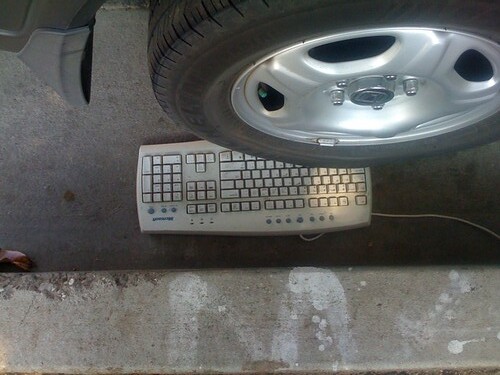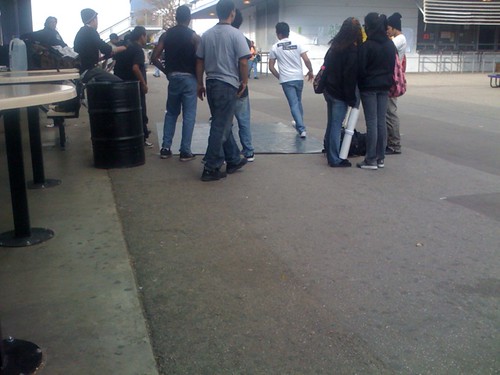Category Archives: rants
Reflections on AERA 09 and the Winners’ Showcase of the Digital Media and Learning Competition Pt. 3: The Continuing Disconnect

As always, I’m amazed by the density of the AERA program. The thousands of sessions that crammed the San Diego Convention Center and adjoining hotels are all over the map and cover just about any discussion you want to be a part of within the world of education. There are always sessions that will help propel my thinking more deeply on various education issues (an obvious highlight this year was Angela Valenzuela’s John Dewey Annual Lecture: “United States Assimilation Policy and Generational Trauma: The Dismembered Passion of Love and Betrayal” in which she claimed that Dewey was clearly a Chicana feminist – awesome!). However, I’m frustrated by the clear divide between the academy and the classroom. Aside from the teachers with whom I shared a panel session*, I see very few classroom teachers at these conferences. Why are we generating this knowledge if were not funneling it back into the classroom?
Likewise, I spent the second half of my week at the Digital Media and Learning Competition Showcase, talking clouds (a larger discussion of the Windy City Black Cloud and the discussions that took place to follow shortly). Along with the 2nd year of winners, the MacArthur/HASTAC showcase bursts with cutting edge learning ideas and applications. As I perused the work the other grant winners undertook over the past year, I was excited about how I could apply these projects to my own classroom. Further, I was thrilled at the morning talk by Connie Yowell – the Director of Education at MacArthur. In it, she basically challenged attendees to think about learning implications in a 21st century environment. She asked us to think about what 21st century assessment looks like. These are things my colleagues and my administrators need to hear. I’m fairly certain I was the only practicing classroom teacher in the room at the time. This isn’t a gloat. I’m concerned that teachers weren’t there to network, to learn, to be inspired. And while AERA, too, has its problems, that the showcase took place at the same time that the majority of educational researchers were on the West Coast, I hope to see a larger connection between digital innovator, researcher, and educator.
Although I’ll talk a bit more about the DML Showcase soon, if you’re interested in seeing a screen a snippet of a short film you can see online but this time on a screen … and then see Cloudy briefly discuss the Black Cloud, by all means.
*Mark and I presented on our Graffiti curriculum. I’m embedding the slides we used for the presentation for those interested.
Reflections on AERA 09 Pt. 1: Looking for the New

At one point during a critical pedagogy session at AERA, I found myself writing in a colleagues notebook, “Where’s the ‘new?!?’” Not a novel thought, I realize. However, I found myself thinking about how are we, as committed educators, pushing for lasting, continually renewed change?
Being committed to what is in the best interest of our students often means doing things that don’t “fit” into traditional educational molds, obviously. For those of us ‘trying to add to the discourse,’ this means needing to be equipped to speak vocally, back our actions with theory, and generally be prepared to further substantiate our claims, decisions, and commitment to our students. In order to speak our students’ language we need to be able to defend it in “theirs.” (I realize an “us/them” dichotomy here is both slightly false and a bit reactionary. However, it may be the easiest way to open up the discussion of educational landscape and needs for South Central and all of the communities that we are living and working within that maybe a bit more “diverse” than some may feel comfortable with.)
If you’re going to say something to the direction and efforts within Critical Pedagogy at AERA, I feel like it needs to be something fully formed, accessible, and clearly pushing the envelope. Otherwise, it feels like a step back from what our already skeptical audience is going to listen to. No, this doesn’t mean conforming… it means being ready to step your game up in the face of adversity and for the sake of our students.
More Complicated Than You Think

And not even in the published shooting script [a bit of cursing to be warned about, for you more puritanical of readers]:
Everything is more complicated than you think. You only see a tenth of what is true. There are a million little strings attached to every choice you make. You can destroy your life every time you choose. But maybe you won’t know for twenty years! And you may never ever trace it to its source. And you only get one chance to play it out. Just try and figure out your own divorce .
And they say there’s no fate, but there is: it’s what you create.
And even though the world goes on for eons and eons, you are only here for a fraction of a fraction of a second. Most of your time is spent being dead, or not yet born. But while alive, you wait in vain wasting years for a phone call or a letter or a look from someone or something to make it all right, but it never comes—or it seems to, but it doesn’t, really.
So you spend your time in vague regret or vaguer hope that something good will come along, something to make you feel connected, something to make you feel cherished, something to make you feel whole, something to make you feel loved. And the truth is, I feel so angry! And the truth is, I feel so fucking sad! And the truth is, I’ve felt so fucking hurt for so fucking long and for just as long, I’ve been pretending I’m okay, just to get along. I don’t know why. Maybe because … no one wants to hear about my misery—because they have their own.
Well, fuck everybody.
Amen.
What that Annoying Pop Song That’s Always On The Radio Says About Learning

I’m fortunate enough to spend a lot of time in my car. It’s Los Angeles, after all, and working and going to school on opposite sides of town lead toward frequently lengthy commutes. Left alone in a silent room long enough and I’ll go crazy – as I am now, sitting in the jury selection room of a Los Angeles courthouse sans headphones. In any case, a lot of my time is spent in the car either arguing to NPR & talk radio or shuffling through CDs (remember those?) and listening discriminately. A week and a half ago, as I was listening to my umpteenth live Otis Redding album for the umpteenth time I felt a profound sense of understanding of the nature of catharsis and learning within song structure. I wasn’t able to put this into words but had a clear understanding of how something as short-lived as “Try A Little Tenderness” inculcates theories of learning within Redding’s performance (James Paul Gee would call this “tacit knowledge”).
That being said, in a generally unscientific way, I’ve been thinking about what “liking” a song or certain style of music tells us about learning. I’ve been trying to put this into words and I think contextualizing it case-by-case may be the easiest way for me to do this over time. Today I’ll jump in with a look at what Top 40 hits mean to my teaching practice.
The Repeat Offender
I’m fascinated with pop culture. I revel in it. I’ve talked about this before. What I like about something like a pop song is that, though it may be “catchy,” it’s not necessarily something that you “like” right away. It doesn’t take a genius to correlate repetition with – if not pleasure – at least acceptance. I’ll provide a schmaltzy example: A few months ago, you couldn’t sit through an hour of top 40 radio without hearing Florida’s “Low.” It was… okay. Of course repeated exposure made it infectiously anthemic. The song (in the words of Gladwell), “tipped:” It was used in a sequence of Tropic Thunder, was used as part of a controversial dance routine, and – within my house – became the short-lived theme song for our resident basset hound.
So what? In terms of learning, we can take a lot away from “Low,” or “Paper Planes,” or “Blame It.” I didn’t “like” these songs because someone told me about them. I didn’t like them because I was regularly reading about how they were made, their history, or their relevance in modern day society (like a frivolous blog post). Instead, I liked these kinds of disposable songs because I experienced them first hand. I interacted regularly with them. I became immersed in contextual uses of these songs next to station IDs, ringtones, film montages, karaoke performances, and personal singing in the shower. We can’t divorce learning from doing from experiencing in this sense. I’m not going to like math by learning about it abstractly; I am going to like that T.I. single* if I’m involved with it. I may make comments about it online, discuss it with friends, and generally use it in my everyday practice. Why aren’t we doing these same things in our classes? Why aren’t English standards being situated within the current economic crisis? Why aren’t we broadly engaging our students in curricula that immerse them in their own experiences? I realize many teachers are indeed doing this and may balk at such questions. However, a look at the landscape of professional development and the continuously bemoaned world of standardization and assessment don’t look toward a different approach at both schooling and education.
I’d also caution people to look toward this analysis as a draconian endorsement of repetition. I do think that revisiting concepts and ideas is a necessary piece of the learning process. However, the analogy of liking a song after hearing it the 37th time on the radio to improving better at English after the 37th essay isn’t the strongest to make. Monitored, situated and repeated practice will get us where we want to go. I liked “Low” more once I contextualized it within a nightclub setting. And heard it in a movie. And talked about it being a “guilty” pleasure with friends. And unbashfully “performed” it for a disinterested hound.
As a final thought, I’d throw out that things as silly and frivolous as pop music and pop culture are necessary additions to our classrooms. Look what is on the student folders as they shuffle in. The patches on their backpacks. The distorted tones of interrupting cell phones. The music played during pep rallies. This is the world that we, as a community, exist within. It is the world that is likely of more import to a student than what may be assessed within your classroom. However, this doesn’t need to be a separate world. Immersing popular culture within my classroom is more than trying to appear cool or hip to my students (they see through that charade immediately!). Instead, illustrating how these “outside” aspects of society not only connect to my curriculum but are actually at the heart of what I teach help students experience (more so than “understand”) the way that English is a part of what will help them become agents of change. The Chris Brown and Rihanna media storm, for instance, became a natural turning point of discussion and understanding when my class read Othello and discussed domestic violence. I realize this may state the obvious, but it needs to be stressed: there is no textbook or curricular guideline that will teach you what aspects of contemporary culture to use in the classroom. We need to engage and understand our society just as our students. We need to learn from them. As a community, we need to build on shared experiences within class.
* As an aside, I’ve been thinking about how T.I. is exemplary of the current problem with hip-hop these days: it’s forgettable. There are a handful of songs by T.I. that I like but I can’t remember a single lyric by him. The draw for all of these songs are the hooks – sung by Rihanna, Justin Timberlake, John Legend, etc. The main attraction – as he’s supposed to be seen – is filler for each hook-laden hit. On the other hand, my fascination for T.I.’s Road to Redemption will require further elaboration at some later point.
Learning to Breathe Underwater

Yes, that’s a group of kids learning to break dance at my school. I was thrilled to see it. As I walked away, I walked behind two girls talking:
– What’s that? Is that called, like, break dancing?
– Yeah, I think so.
– That’s weird.
It basically being finals week for me, things have been a bit hectic on the doctoral side of things (hence the rather long gap between updates in these here parts of the woods). However, I’ve been thinking lately about the implications of space and understandings of it. This relates in numerous ways to research I’m doing in my classes: space and meaning in disciplinary interactions between students and adults, the way graffiti “codes” space within the Manual Arts community, the way new media opens up and occludes space based on access, etc.
I’ve also been trying to think about the way one’s personal space needs to be made more explicit – labeled even, though that sounds wrong and not at all the way I think of borders as splitting us into different people or different kinds of people. (These are thoughts that demand run ons.) I think one of my biggest flaws over the past two quarters has been about being too amorphous. I don’t think I’ve done quite enough reflecting to really make sense of this here other than to say I’m working toward reprioritizing the way I deal with the different hats I wear. Even within the school setting, the teacher hat, mentor hat, advisor hat, and all-that-stuff-that-takes-place-outside-of-my-class-that-gets-mistakenly-labeled-as-“important” hat are occasionally being donned in the wrong order and for the wrong duration. I don’t want to say like I feel like I let my kids down this quarter, but – like most of us – I certainly think I could have given them more. And of course that’s what they deserve and that’s what they should be demanding. Within other spheres I think I’ve been complicating things by continuing to wear – say – the “doctoral student” hat way too often when maybe the hat I should be wearing is something like the wash-the-dishes-and-make-sure-Sadie-isn’t-destroying-the-house hat. Perhaps this sounds more mundane than what I mean but (and again with the run on) space is being construed and interpreted too fluidly and I’m not coming up for air frequently enough to realize that swimming goggles are out of place in a jacket and tie affair.
Arthur has been consistently great with it’s online content. A couple of links I’m throwing here come directly from them, so please support your local/global counterculture zine as much as possible – one of the few publications I feel strongly bout schlepping for. In any case, this article on the NYU occupation felt thrilling. It – also about space – makes me cognizant about the challenges with actualizing the kinds of libratory changes many of us are trying to instill in our students. I’m not worried about how they will be viewed or judged by the mass media, but the article makes it clear what script-flipping will need to look like. Similarly, our Third Space Collaborative met for the second time yesterday. I plan to jot something about that when I find another free moment. Suffice for now, I’ll throw out a thought: is this considered an eco-third space? I think of the tenuous balance between living on and off grid simultaneously and the way such a space could function academically (and no, charters are NOT doing this).
Finally and hot off the presses… er… hot from the oven? I’m excited about the playtest that Greg just wrote about. I think Greg’s game fits in well with this post’s weakly culled theme of space and interpretations of it. I’d be inspired to jump into participating in round 2 of this baking madness if only my biscuit making skills were up to snuff (Daye: kick the recipe over here!). Perhaps my Koreatown neighbors could settle for muffins?
[I Need Your Help!] Lamenting Signs of the Times: What Will Happen to Education and Citizens’ Voice?

The state of education in Los Angeles today: Whose voices are being represented? Whose voices are being heard?
For the majority of 2008, I was regularly blogging for the LA Times’ education blog, The Homeroom. Although I didn’t post as regularly as I’d wanted to (perhaps the challenge facing any blog contributor), I was generally excited about getting authentic experiences, challenges, and questions arising from Manual Arts to a larger audience. More than that, I was enticed by the prospect of opening up occasionally difficult conversations for readers at large. Since I was writing largely for non-educators, I was hoping to present a more sobering, realistic vision of what we experience at our schools on a day-to-day basis. No more Freedom Writers, but also no more stereotypes of a purely “dangerous” school and community.
If I could write about school life in a way that could make readers squirm, I felt like I was doing my job (after all, I landed the writing gig after basically emailing the editor at the time and asking why the only teachers represented at the time were from the Teach For America Program). I’m not trying to paint myself as a self-righteous Zorro in the edu-blogging sphere. However, I am pleased by the strongly worded comments that would occasionally follow posts I authored. My second post – about the CAHSEE “Boot Camp” that our school instituted – was followed by a reader accusing me of being a “classist” and not being able to see “the big picture.” Similarly, I regularly blogged about the graffiti curriculum a colleague and I were developing and implementing. The long string of angry comments that followed those posts was thrilling. It wasn’t just the fact that someone would be angry enough to say I was not fit to work with students (going as far as insinuating that I should be behind bars), it was the idea that people at large – not just educators – were engaging in much-needed dialogue about education. This dialogue, admittedly, was limited and often only reactionary. However, it was a step toward re-centering the school in society.
All that being said, I am concerned about the state of the LA Times. Aside from having an official connection to the paper via The Homeroom, I don’t necessarily consider myself an LA Times-apologist. And while there are numerous outlets for us to get our news in this 2.0 day and age, I think there is a lot of value in a strong print media in the city. (Yes, critical theorists out there, I realize there are a lot of problems with this as a blanket statement.) I am distressed by the news that the LA Times are effectively cutting the local/California section of the paper. While it’s being framed as an effort to improve news at large, I can’t imagine that the few local education stories slotted into the paper’s B section will grow in any dramatic section now folded into the main A part of the paper. (It’s not like there’s now more Howard Blume to go around!) I am also wary of the many, many more cuts being made to the Times’ staff. I don’t feel equipped, at the moment, to offer a full critique of the economic decisions or situation at the LA Times or at large. However, it feels strikingly similar to the notion of the district cutting teachers in LAUSD to deal with facing budget cuts while still claiming to be interested in improving student education. Someone’s logic is a bit flawed, regardless of monthly bottom line.
Long story short, I didn’t choose to stop blogging for the LA Times in November, December and now in 2009. The paper basically cut the blog (along with a few others). There was word of folding it into the LA Times main LA Now blog at some point (the site that The Homeroom now automatically directs visitors). I can’t imagine that this will be happening anytime soon with the stretching of staff over there.
A Call For Action
As perhaps a way to turn this into a more optimistic post than those initial ‘graphs suggested, I’d like to offer up a thought. As I said, I think it’s important for educators and non-educators to be involved in larger discussions about what’s taking place in classrooms today. I think this should take place in a way that feels local for now, to help change the way most people turn to look to federal changes as a sign of what’s taking place in education (Ask the average adult and I bet they could at least say what NCLB stands for. Ask the average adult how NCLB mandates are affecting the closest public school in their community – even if they have children enrolled there – and I don’t think you’d get as consistent a response). If the LA Times aren’t going to do it (and they don’t necessarily should/have to), let’s get a general space for educators and non-educators to share and discuss education as it takes place in Los Angeles. Sure, there are plenty of sites of about education out in oceans of urls. However, what if LA had a consistent place of dialogue for its educational needs and experiences. What would you say? How would you say it? Anyone else interested or have any ideas about how to build something like this?
A More Tolerant (Real) World
I realize you may not be able to hear me over the general choir of groaning that this post will explore current reality television, but I assure you, there is some good news here.
I’ve now seen the first two episodes of the current season of the Real World, where not 7, but 8 lucky twenty-somethings get picked to live together to see what happens when people stop being polite blah blah blah.
What’s most interesting in this season is that – at least in these first two hours – the show has deemphasized the sex-crazed shenanigans of the past half-dozen seasons. Instead, the group is diversified to a point beyond any kind of legitimate “real” world. However, thrown in with the very straight-laced metro-sexual Mormon, the aspiring dancer, the guy with the abs, and the guy with Iraq-related PTSD, are a gay man (who used to train dolphins at Sea World – awesome), a girl that – up until her present relationship – used to date women exclusively, and a transgendered woman.
Looking at that roster, that’s a pretty hefty dose of sexuality for our impressionable youth. I couldn’t be happier. In these first shows, it’s interesting how the show is edited; clearly the two gentlemen that are not used to/comfortable around homosexuality are coming off the worse for wear. Their reactions and types of jokes they make are clearly supposed to be “not funny” to viewers at home. The way they speculated about their transgendered roommate – going as far at one point as referring to her as “it” – isn’t something that they’ll be getting praise for after the season is over. And when one of these guys is pecked on the lips by a drag queen at a gay bar, the way he violently wipes his lips and looks disgusted is downright upsetting (though this, unlike the other examples, is contrasted with the delighted cackles of the rest of the roommates).
Sure, the show is likely to devolve into fights, hook-ups, and tears in the coming episodes. However, for now, the Real World is opening up concepts of – and flat-out endorsing – tolerance for the millions watching the show. That’s got to be worth something, right?
Why We Can’t Get It Right (Comics Edition)

I stumbled across this interview last week and immediately groaned. Great, another non-educator (yes, this can even include former educators) showing us how to teach. That sounds pessimistic and mean spirited, but it is intended more as a commentary on how teachers are pushed into a passive role within the educational field.
As a traveling teacher, I spent two months of the year “borrowing” the classroom of a follow colleague who’s shelves positively burst with comics: a class set of the Watchmen, numerous copies of Maus, and Persepolis (since they have somehow become the only comics that teachers acknowledge as existing…), plenty of that dirty stuff we’re supposed to keep away from kids (aka Vertigo titles, Strangers in Paradise, The Walking Dead), tons of superheroes, manga, you name it. The teacher spent a fortune, I presume, on these titles. I saw him utilizing comics in his curriculum on a regular basis (I recall, for instance, a unit on autobiographical writing using some of the aforementioned texts as well as The Rabbi’s Cat and a manga title I was unfamiliar with).
I asked some of his kids about the comics and all of them – I repeat, all of them – said they were fun to read. Both male and female students read a hefty helping of comic books. Kids regularly trickled in during lunch to pick up the latest trade they were reading. This teacher successfully incorporated comics into his everyday teaching practice. Kids were engaged during silent reading, throughout the lesson, and even at home. The comics helped transition reluctant readers toward standard-fare novels.
No one paid this teacher to develop a comic book framework for his classroom. He didn’t go to buy a manual showing him how to use comics in a standards-aligned classroom. Instead, he found an instructional strategy (clearly one he was already passionate about), and figured out how to best engage and personalize the learning experiences for his students. From the overwhelming anecdotal evidence I received from his students over the two months I spent in his class, it was clearly an effective model. This is the teacher that should have penned a book about utilizing comics. He should be leading professional development sessions for our school and our district.
I single this teacher out in this instance to illustrate that there are similar skills represented by all of our teachers. Think about the sheer amount of expertise that is being disregarded within our schools. Sharing such work at annual conferences and in journals isn’t going to be enough (even though I participate in both mediums): frankly, I suspect it’s the same select cadre of teachers from schools circling within these pools. The vast majority of the teachers – at my school at least – are not going to conferences or reading journals (it’s the work for the perceived “teacher leaders”: department chairs, coaches, and ‘those loudmouths that speak up in faculty meetings’).
If we want to get things right it’s going to take a larger shift in how teachers are perceived.
It’s going to have to start with how we perceive ourselves.
I haven’t looked at – let alone read – Comics in Your Curriculum. I can’t vouch for whether it is any good. However, reading the interview, I question why this book came into existence without the consultation of (let alone being authored by) teachers. I didn’t intend to pick on this title in particular, it acts as more of an exemplar of what I am arguing against. As a group of disenfranchised professionals, there isn’t any reason why we shouldn’t be developing these kinds of plans and manuals alongside our students. Why are we letting publishers and textbook tycoons dictate our careers for us? I’m all for having guests come in and aid and collaborate in the classroom. However, it’s time to shift how curriculum is manufactured, interpreted, and consumed. It’s time to make sure teachers are a part of this process every step of the way.
“Where there was once one, there are now two.”

“What is a reflection? A chance to see two? When there are chances for reflections, there can always be two–or more. Only when we are everywhere will there be just one.” – Log Lady